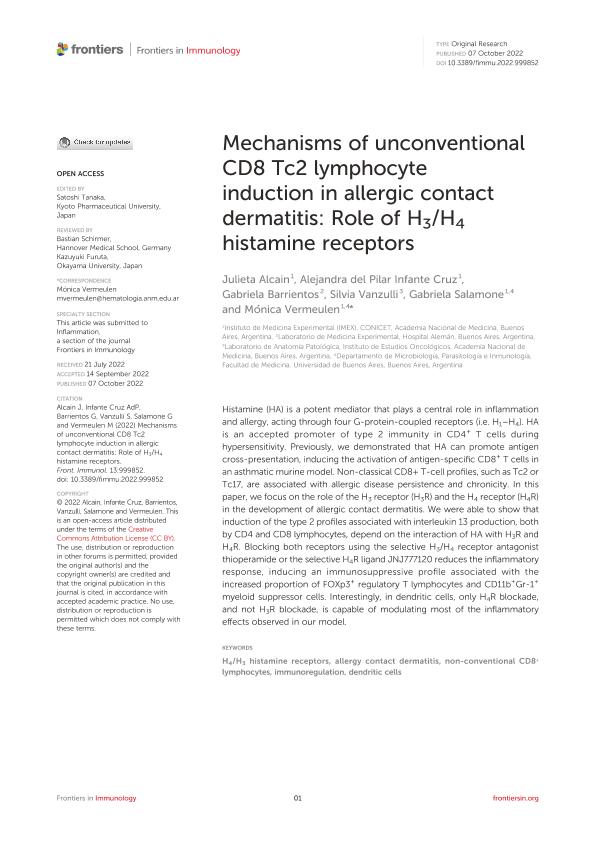Artículo
Mechanisms of unconventional CD8 Tc2 lymphocyte induction in allergic contact dermatitis: Role of H3/H4 histamine receptors
Alcain, Julieta María ; Infante Crúz, Alejandra del Pilar
; Infante Crúz, Alejandra del Pilar ; Barrientos, Gabriela Laura
; Barrientos, Gabriela Laura ; Vanzulli, Silvia; Salamone, Gabriela Veronica
; Vanzulli, Silvia; Salamone, Gabriela Veronica ; Vermeulen, Elba Monica
; Vermeulen, Elba Monica
 ; Infante Crúz, Alejandra del Pilar
; Infante Crúz, Alejandra del Pilar ; Barrientos, Gabriela Laura
; Barrientos, Gabriela Laura ; Vanzulli, Silvia; Salamone, Gabriela Veronica
; Vanzulli, Silvia; Salamone, Gabriela Veronica ; Vermeulen, Elba Monica
; Vermeulen, Elba Monica
Fecha de publicación:
10/2022
Editorial:
Frontiers Media
Revista:
Frontiers in Immunology
ISSN:
1664-3224
Idioma:
Inglés
Tipo de recurso:
Artículo publicado
Clasificación temática:
Resumen
Histamine (HA) is a potent mediator that plays a central role in inflammation and allergy, acting through four G-protein-coupled receptors (i.e. H1–H4). HA is an accepted promoter of type 2 immunity in CD4+ T cells during hypersensitivity. Previously, we demonstrated that HA can promote antigen cross-presentation, inducing the activation of antigen-specific CD8+ T cells in an asthmatic murine model. Non-classical CD8+ T-cell profiles, such as Tc2 or Tc17, are associated with allergic disease persistence and chronicity. In this paper, we focus on the role of the H3 receptor (H3R) and the H4 receptor (H4R) in the development of allergic contact dermatitis. We were able to show that induction of the type 2 profiles associated with interleukin 13 production, both by CD4 and CD8 lymphocytes, depend on the interaction of HA with H3R and H4R. Blocking both receptors using the selective H3/H4 receptor antagonist thioperamide or the selective H4R ligand JNJ777120 reduces the inflammatory response, inducing an immunosuppressive profile associated with the increased proportion of FOXp3+ regulatory T lymphocytes and CD11b+Gr-1+ myeloid suppressor cells. Interestingly, in dendritic cells, only H4R blockade, and not H3R blockade, is capable of modulating most of the inflammatory effects observed in our model.
Archivos asociados
Licencia
Identificadores
Colecciones
Articulos(IMEX)
Articulos de INST.DE MEDICINA EXPERIMENTAL
Articulos de INST.DE MEDICINA EXPERIMENTAL
Articulos(SEDE CENTRAL)
Articulos de SEDE CENTRAL
Articulos de SEDE CENTRAL
Citación
Alcain, Julieta María; Infante Crúz, Alejandra del Pilar; Barrientos, Gabriela Laura; Vanzulli, Silvia; Salamone, Gabriela Veronica; et al.; Mechanisms of unconventional CD8 Tc2 lymphocyte induction in allergic contact dermatitis: Role of H3/H4 histamine receptors; Frontiers Media; Frontiers in Immunology; 13; 10-2022; 1-13
Compartir
Altmétricas



